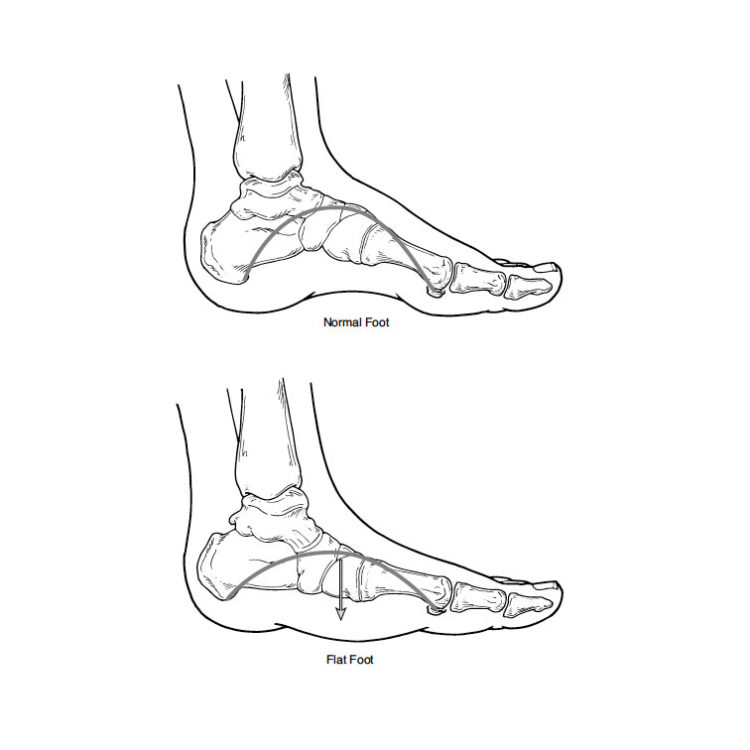FOOT & ANKLE CONDITIONS
What Is Flatfoot?
Flatfoot is often a complex disorder, with diverse symptoms and varying degrees of deformity and disability.
There are several types of flatfoot, all of which have one characteristic in common—partial or total collapse (loss) of the arch.

Other characteristics shared by most types of flatfoot include:
• “Toe drift,”where the toes and front part of the foot point outward
The heel tilts toward the outside and the ankle appears to turn in.
• Ashort Achilles tendon, which causes the heel to lift off the ground earlier when walking and may act as a deforming force
• Bunions and hammertoes may occur in some people with flatfeet. Health problems such as rheumatoid arthritis or diabetes sometimes increase the risk of developing flatfoot. In addition, adults who are overweight frequently have flatfoot.
Flexible Flatfoot
Flexible flatfoot is one of the most common types of flatfoot. It typically begins in childhood or adolescence and continues into adulthood. It usually occurs in both feet and generally progresses in severity throughout the adult years.As the deformity worsens, the soft tissues (tendons and ligaments) of the arch may stretch or tear and can become inflamed. The term “flexible” means that while the foot is flat when standing (weight-bearing), the arch returns when not standing. In the early stages of flexible flatfoot arthritis is not restricting motion of the arch and foot, but in the later stages arthritis may develop to such a point that the arch and foot become stiff. Symptoms, which may occur in some persons with flexible flatfoot, include:
• Pain in the heel, arch, ankle, or along the outside of the foot
• “Turned-in” ankle • Pain associated with a shin splint
• General weakness/fatigue in the foot or leg
Diagnosis of Flexible Flatfoot
In diagnosing flatfoot, the podiatric foot and ankle surgeon examines the foot and observes how it looks when you stand and sit. X-rays are usually taken to determine the severity of the disorder. If you are diagnosed with flexible flatfoot but you don’t have any symptoms, your podiatric surgeon will explain what you might expect in the future.
Treatment Options
If you experience symptoms with flexible flatfoot, the podiatric surgeon may recommend various treatment options, including:
• Activity modifications. Cut down on activities that bring you pain and avoid prolonged walking and standing to give your arches a rest.
• Weight loss. If you are overweight, try to lose weight. Putting too much weight on your arches may aggravate your symptoms.
• Orthotic devices. Your podiatric surgeon can provide you with custom orthotic devices for your shoes to give more support to the arches.
• Immobilization. In some cases, it may be necessary to use a walking cast or to completely avoid weight-bearing.
• Medications. Nonsteroidal antiinflammatory drugs (NSAIDs), such as ibuprofen, help reduce pain and inflammation.
• Physical therapy. Ultrasound therapy or other physical therapy modalities may be used to provide temporary relief.
• Shoe modifications. Wearing shoes that support the arches is important for anyone who has flatfoot.
• Surgery. In some patients whose pain is not adequately relieved by other treatments, surgery may be considered.
Flatfoot Surgery
A variety of surgical techniques is available to correct flexible flatfoot. Your case may require one procedure or a combination of procedures.All of these surgical techniques are aimed at relieving the symptoms and improving foot function.Among these procedures are tendon transfers or tendon lengthening procedures, realignment of one or more bones, joint fusions, or insertion of implant devices. In selecting the procedure or combination of procedures for your particular case, the podiatric surgeon will take into consideration the extent of your deformity based on the x-ray findings, your age, your activity level, and other factors. The length of the recovery period will vary, depending on the procedure or procedures performed.
SCHEDULE AN APPOINTMENT FOR AN EVALUATION.

